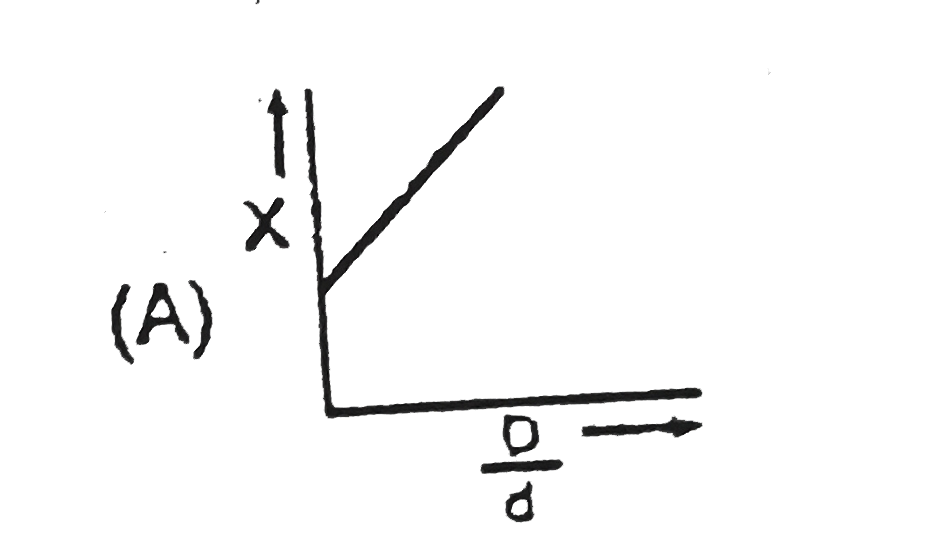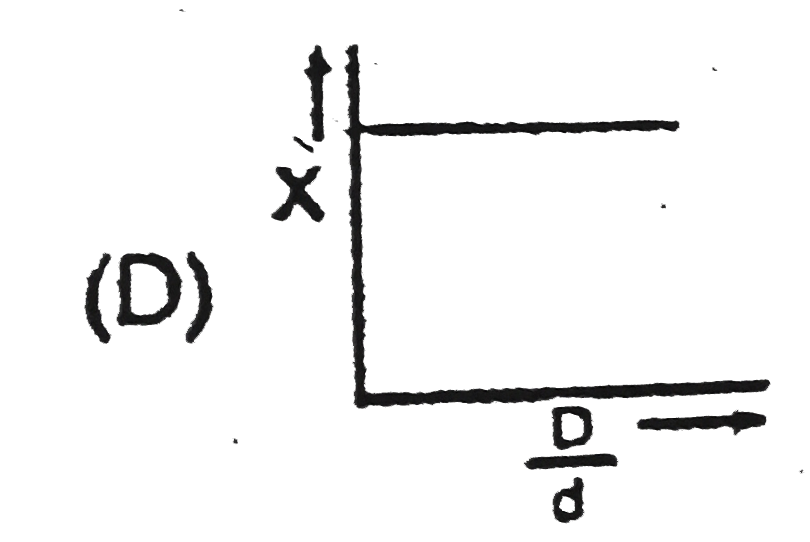For certain substances such as ammonium chloride, nitrogen peroxide, phosphorus pentachloride, etc. the measured densities are found to be less than those calculated from their molecular formula.The observed densities decreases towards a limit as the temperature is raised.This is due to the splitting of the molecular into simpler ones.The process is reversible and is called thermal dissociation.
Example :
With increase in the number of molecules, the volume increases (pressure remaining constant) and in consequence, the density decreases.As the temperature rises, more and more dissociation takes place, and when practically complete dissociation occurs the density reaches its lowest limit.
The extent of dissociation, i.e., the fraction of the total number of molecules which suffers dissociation is called the degree of dissociation.Gas density measurements can be used to determine the degree of dissociation.Let us take by general case where one molecule of a substance A splits up into n molecule of A on heating , i.e.,
Total no. of moles =
=
Observed molecular weight or molar mass of the mixture
=Molar mass of gas
x(degree of dissociation) varies with in the above reaction according to :




The correct Answer is:B
which is a line with positive slope and X intercept =1
Topper's Solved these Questions
Similar Questions
Knowledge Check
For certain substances such as ammonium chloride, nitrogen peroxide, phosphorus pentachloride, etc. the measured densities are found to be less than those calculated from their molecular formula.The observed densities decreases towards a limit as the temperature is raised.This is due to the splitting of the molecular into simpler ones.The process is reversible and is called thermal dissociation.
Example : NH4Cl⇔NH3+HClI2⇔2I
N2O4⇔2NO2PCl5⇔PCl3+Cl2
With increase in the number of molecules, the volume increases (pressure remaining constant) and in consequence, the density decreases.As the temperature rises, more and more dissociation takes place, and when practically complete dissociation occurs the density reaches its lowest limit.
The extent of dissociation, i.e., the fraction of the total number of molecules which suffers dissociation is called the degree of dissociation.Gas density measurements can be used to determine the degree of dissociation.Let us take by general case where one molecule of a substance A splits up into n molecule of A on heating , i.e.,
An(g)⇔nA(g)
t=0 a 0
t=teqa−xn.xα=xa⇒x=aα.
a−aαnaα
Total no. of moles =a−aα+naα
=[1+(n−1)α]a
Observed molecular weight or molar mass of the mixture
Mmixture=MAn[1+(n−1)α],MAn=Molar mass of gas An
The equation α=D−d(n−1)d is correctly matched for :AA⇔nB/2+nC/3BA⇔nB/3+(2n/3)CCA→(n/2)B+(n/4)CDA⇔(n/2)B+CFor certain substances such as ammonium chloride, nitrogen peroxide, phosphorus pentachloride, etc. the measured densities are found to be less than those calculated from their molecular formula.The observed densities decreases towards a limit as the temperature is raised.This is due to the splitting of the molecular into simpler ones.The process is reversible and is called thermal dissociation.
Example : NH4Cl⇔NH3+HClI2⇔2I
N2O4⇔2NO2PCl5⇔PCl3+Cl2
With increase in the number of molecules, the volume increases (pressure remaining constant) and in consequence, the density decreases.As the temperature rises, more and more dissociation takes place, and when practically complete dissociation occurs the density reaches its lowest limit.
The extent of dissociation, i.e., the fraction of the total number of molecules which suffers dissociation is called the degree of dissociation.Gas density measurements can be used to determine the degree of dissociation.Let us take by general case where one molecule of a substance A splits up into n molecule of A on heating , i.e.,
An(g)⇔nA(g)
t=0 a 0
t=teqa−xn.xα=xa⇒x=aα.
a−aαnaα
Total no. of moles =a−aα+naα
=[1+(n−1)α]a
Observed molecular weight or molar mass of the mixture
Mmixture=MAn[1+(n−1)α],MAn=Molar mass of gas An
If the total mass of a mixture in the above case is 300 gm, the moles of C(g) present are.A14 moleB43 moleC34 moleDNoneFor certain substances such as ammonium chloride, nitrogen peroxide, phosphorus pentachloride, etc. the measured densities are found to be less than those calculated from their molecular formula.The observed densities decreases towards a limit as the temperature is raised.This is due to the splitting of the molecular into simpler ones.The process is reversible and is called thermal dissociation.
Example : NH4Cl⇔NH3+HClI2⇔2I
N2O4⇔2NO2PCl5⇔PCl3+Cl2
With increase in the number of molecules, the volume increases (pressure remaining constant) and in consequence, the density decreases.As the temperature rises, more and more dissociation takes place, and when practically complete dissociation occurs the density reaches its lowest limit.
The extent of dissociation, i.e., the fraction of the total number of molecules which suffers dissociation is called the degree of dissociation.Gas density measurements can be used to determine the degree of dissociation.Let us take by general case where one molecule of a substance A splits up into n molecule of A on heating , i.e.,
An(g)⇔nA(g)
t=0 a 0
t=teqa−xn.xα=xa⇒x=aα.
a−aαnaα
Total no. of moles =a−aα+naα
=[1+(n−1)α]a
Observed molecular weight or molar mass of the mixture
Mmixture=MAn[1+(n−1)α],MAn=Molar mass of gas An
The KP for the reaction N2O4⇔2NO2 is 640 mm at 775 K.The percentage dissociation of N2O4 at equilibrium pressure of 160 mm is :A80%B30%C50%D70%
Ammonium chloride dissociates as,
NH4Cl(g)⇔NH3(g)+HCl(g)
The vapour density becomes half the initial value when degree of dissociation is 0.5.
View SolutionFor certain substances such as ammonium chloride, nitrogen peroxide, phosphorus pentachloride, etc. the measured densities are found to be less than those calculated from their molecular formula.The observed densities decreases towards a limit as the temperature is raised.This is due to the splitting of the molecular into simpler ones.The process is reversible and is called thermal dissociation.
Example : NH4Cl⇔NH3+HClI2⇔2I
N2O4⇔2NO2PCl5⇔PCl3+Cl2
With increase in the number of molecules, the volume increases (pressure remaining constant) and in consequence, the density decreases.As the temperature rises, more and more dissociation takes place, and when practically complete dissociation occurs the density reaches its lowest limit.
The extent of dissociation, i.e., the fraction of the total number of molecules which suffers dissociation is called the degree of dissociation.Gas density measurements can be used to determine the degree of dissociation.Let us take by general case where one molecule of a substance A splits up into n molecule of A on heating , i.e.,
An(g)⇔nA(g)
t=0 a 0
t=teqa−xn.xα=xa⇒x=aα.
a−aαnaα
Total no. of moles =a−aα+naα
=[1+(n−1)α]a
Observed molecular weight or molar mass of the mixture
Mmixture=MAn[1+(n−1)α],MAn=Molar mass of gas An
A sample of mixture of A(g),B(g) and C(g) under equilibrium has a mean molecular weight (observed ) is 80.
The equilibrium is A(g)(mol.wt.=100)⇔B(g)(mol.wt.=60)+C(g)(mol.wt.=40)
Find the degree of dissociation α for A(g)
View SolutionNH4Cl⇔NH3+HCl reaction is called
View SolutionDuring thermal dissociation, the observed vapour density of N2O4(g) is 26.0. The extent of dissociation of N2O4 is:
View SolutionThe vapour density of undecomposed N2O, is 46. When heated, the vapour density decreases to 24.5 due to its dissociation to NO2. The percentage dissociation of N2O4 at the final temperature is
View Solution
